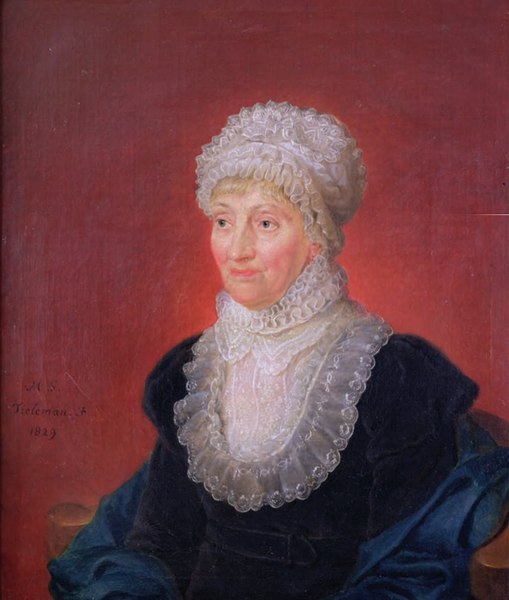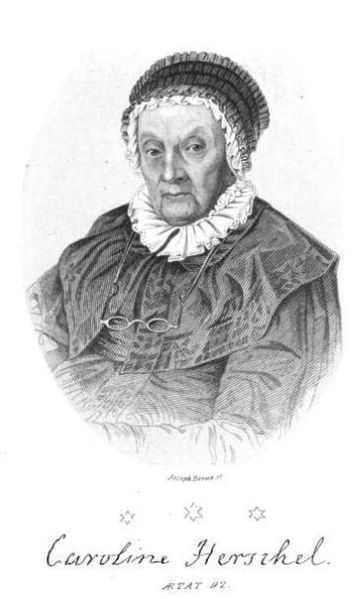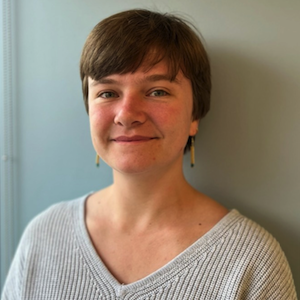
For thousands of years, people have observed the night sky, working to unravel the mysteries it beholds, decipher the stars, and map the cosmos. Today marks the birthday of a luminary astronomer who discovered multiple comets and star clusters and laid the foundation for the star catalog, which is still used by astronomers worldwide. Join us in exploring the life and legacy of Caroline Herschel.
A Beginning in Music
Caroline Lucretia Herschel was born on March 16, 1750, in Hanover, Germany. Her father encouraged all six of his children to study music and mathematics, ultimately inspiring a passion for both subjects in Caroline and her brother William, in particular. At age 10, Caroline was stricken with typhus, which stunted her growth. By age 22, she moved out of her hometown to Bath, England, where her brother William resided. While in Bath, Caroline was taught mathematics and provided with voice lessons from William, who was an accomplished musician and conductor at the time. She went on to become a professional soprano singer.

Portrait of Caroline Herschel, 1829. This work is in the public domain in its country of origin and other countries and areas where the copyright term is the author’s life plus 70 years or fewer, via Wikimedia Commons.
Discovering Caroline’s Cluster
Caroline and her brother shared a mutual fascination in astronomy, with William building telescopes on his free time and mentoring Caroline in the craft. Ultimately, their interest in this work prompted them to leave their musical careers in 1782 and pursue astronomy and telescope making full time. William had been appointed by King George III as Court Astronomer, and Caroline worked as his unofficial assistant. During this time, she recorded and organized her brother’s observations on celestial bodies like stars and nebulae, while also performing many calculations for his research on the cosmos, thereby developing the modern mathematical approach to cataloging astronomy.
Caroline also made many of her own independent contributions to astronomy. In 1783, when observing the constellation of Canis Major, Caroline discovered the open star cluster known as NGC 2360, Caldwell 58, or “Caroline’s Cluster”. Three years later, in August, 1786, she noticed a shape moving slowly across the sky over the course of several nights. This shape was what is now known as Comet C/1786 P1 (Herschel). For these accomplishments, she was officially recognized as a talented astronomer, and in 1787, King George III employed her as her brother’s assistant, which made her the first woman to be paid for scientific work.

Map of NGC 2360. Image by Roberto Mura and licensed under CC BY-SA 3.0, via Wikimedia Commons.
A Legacy in the Stars
Throughout her career as an astronomer, Caroline Herschel discovered eight comets between 1786–1797, as well as M110 (or NGC 205), a dwarf elliptical galaxy that is a satellite of Andromeda.

The Andromeda Galaxy and its satellite galaxy, Messier 110, near the bottom-right of the center. Licensed under CC BY 2.0, via Flickr Creative Commons.
Caroline and William sought to improve the current star map of their time, the Historia Coelestis Britannica, a catalog of almost 3000 stars, compiled by the first astronomer royal of England, John Flamsteed. Over a period of 20 months, Caroline checked, calculated, corrected, and updated the Historia Coelestis Britannica, publishing the updated work in 1798, after having made numerous corrections and adding 500 extra stars. In addition, Caroline and William published the Catalogue of Nebulae and Clusters of Stars in 1786, which William’s son, John Herschel, also with the assistance of Caroline, expanded into the General Catalogue of Nebulae and Clusters of Stars to include more newly discovered stars. These catalogs were the precursors to Dreyer’s New General Catalogue (NGC), which was compiled in 1888 and is currently used by astronomers.
Alongside Caroline’s firsthand discoveries, both an asteroid, Lucretia, and a small lunar crater, C. Herschel, are named in her honor. The Royal Astronomical Society in partnership with the German Astronomical Society awards The Caroline Herschel Medal to outstanding women astrophysicists in the United Kingdom and Germany. A handwritten draft of Caroline Herschel’s memoirs is displayed in the Herschel Museum, located in the Herschel’s former home in Bath, England.

Portrait of Caroline Herschel, the noted astronomer, at age 92. The original had been a lithography (1848 and earlier) by George Müller, lithographer and photographer in Hanover. This media file is in the public domain in the United States, via Wikimedia Commons.
Caroline Herschel spent most of her life studying the night sky, and her discoveries helped found contemporary astronomical methods. Next time you look at the stars, you can recall the woman who helped discover and catalog them almost 300 years ago.
Further Reading
Learn more about Caroline Herschel:
Read about more astronomers on the COMSOL Blog:
- Subrahmanyan Chandrasekhar, who changed our understanding of stellar structure and evolution
- Cecilia Payne-Gaposchkin, who identified that stars and the Sun are mostly made from helium and hydrogen
- Friedrich Bessel, who improved methods of measurement and observation in astronomy





Comments (0)